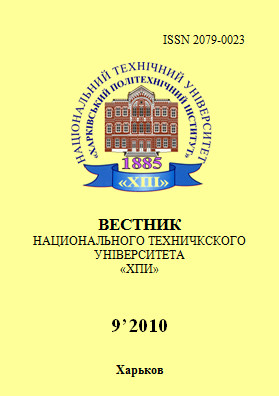Компьютерное моделирование формирования поверхности тонких плёнок кинетическим методом Монте-Карло
DOI:
https://doi.org/10.20998/%25xAbstract
В работе разработана модель осаждения тонких плёнок, основанная на методе кинетического Монте-Карло. Предложенный алгоритм учитывает процессы диффузии по адатомным узлам кристаллической решетки, а также эффект затенения осаждаемых атомов неровностями рельефа поверхности. Проведенные расчеты показывают хорошее согласие с имеющимися экспериментальными результатами.References
Mattox D.M., Handbook of Physical Vapor Deposition (PVD) Processing// William Andrew Publishing/Noyes -1998. –P.- 907.
Smith R. W., Srolovitz D. J. Void formation during film growth: A molecular dynamics simulation study// J. Appl. Phys.- 1996.-Vol. 79.- P. 1448-1457.
Srolovitz D. J., Mazor A., Bukiet B. G. Analytical and numerical modeling of columnar evolution in thin films //J. of Vac. Science & Technology.-1988.- Vol. A6.- P. 2371-2380.
Kohler U., Jensen C., Reshort K., et. al. Homo- and heteroepitaxy of metal on metal growth// Structure dynamics in heterogeneous systems.-Singapore: World Scientific, 2001.- P. 140-147.
Биддер К., Сиперли Д., Ансен Ж.-П. и др Методы Монте-Карло в статистической физике/ Пер. с англ.- М.: Мир, 1982.- 400 с.
Бокштейн Б.С., Бокштейн С.С., Жуховицкий А. А. Термодинамика и кинетика диффузии в твердых телах /М.: Металлургия, 1974.- 280 с.
Downloads
Published
How to Cite
Issue
Section
License
Copyright (c) 2015 Вестник Национального технического университета "ХПИ". Серия: Системный анализ, управление и информационные технологииAuthors who publish with this journal agree to the following terms:
- Authors retain copyright and grant the journal right of first publication with the work simultaneously licensed under a Creative Commons Attribution License that allows others to share the work with an acknowledgement of the work's authorship and initial publication in this journal.
- Authors are able to enter into separate, additional contractual arrangements for the non-exclusive distribution of the journal's published version of the work (e.g., post it to an institutional repository or publish it in a book), with an acknowledgement of its initial publication in this journal.
- Authors are permitted and encouraged to post their work online (e.g., in institutional repositories or on their website) prior to and during the submission process, as it can lead to productive exchanges, as well as earlier and greater citation of published work (See The Effect of Open Access).


